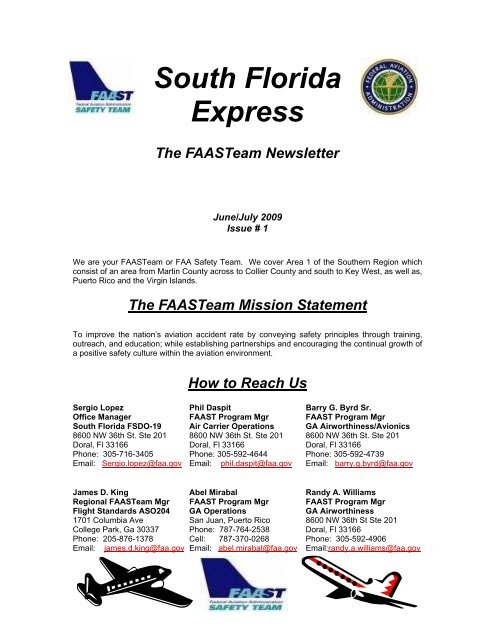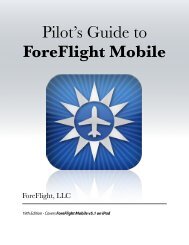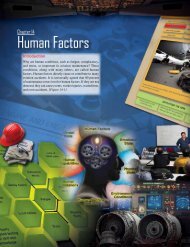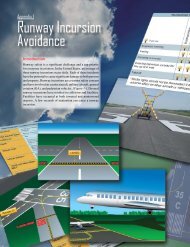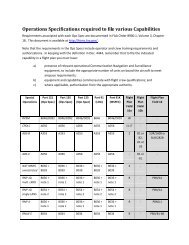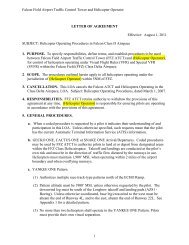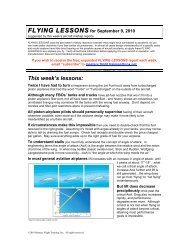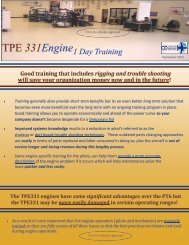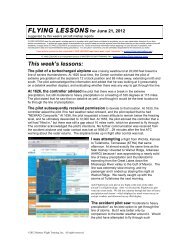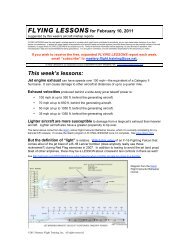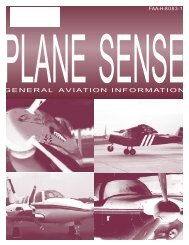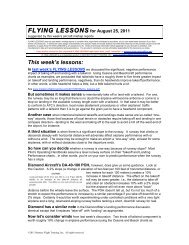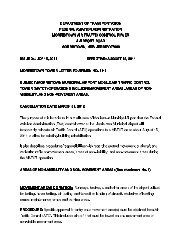South Florida Express - FAASafety.gov
South Florida Express - FAASafety.gov
South Florida Express - FAASafety.gov
You also want an ePaper? Increase the reach of your titles
YUMPU automatically turns print PDFs into web optimized ePapers that Google loves.
<strong>South</strong> <strong>Florida</strong><br />
<strong>Express</strong><br />
The FAASTeam Newsletter<br />
June/July 2009<br />
Issue # 1<br />
We are your FAASTeam or FAA Safety Team. We cover Area 1 of the <strong>South</strong>ern Region which<br />
consist of an area from Martin County across to Collier County and south to Key West, as well as,<br />
Puerto Rico and the Virgin Islands.<br />
The FAASTeam Mission Statement<br />
To improve the nation’s aviation accident rate by conveying safety principles through training,<br />
outreach, and education; while establishing partnerships and encouraging the continual growth of<br />
a positive safety culture within the aviation environment.<br />
How to Reach Us<br />
Sergio Lopez Phil Daspit Barry G. Byrd Sr.<br />
Office Manager FAAST Program Mgr FAAST Program Mgr<br />
<strong>South</strong> <strong>Florida</strong> FSDO-19 Air Carrier Operations GA Airworthiness/Avionics<br />
8600 NW 36th St. Ste 201 8600 NW 36th St. Ste 201 8600 NW 36th St. Ste 201<br />
Doral, Fl 33166 Doral, Fl 33166 Doral, Fl 33166<br />
Phone: 305-716-3405 Phone: 305-592-4644 Phone: 305-592-4739<br />
Email: Sergio.lopez@faa.<strong>gov</strong> Email: phil.daspit@faa.<strong>gov</strong> Email: barry.g.byrd@faa.<strong>gov</strong><br />
James D. King Abel Mirabal Randy A. Williams<br />
Regional FAASTeam Mgr FAAST Program Mgr FAAST Program Mgr<br />
Flight Standards ASO204 GA Operations GA Airworthiness<br />
1701 Columbia Ave San Juan, Puerto Rico 8600 NW 36th St Ste 201<br />
College Park, Ga 30337 Phone: 787-764-2538 Doral, Fl 33166<br />
Phone: 205-876-1378 Cell: 787-370-0268 Phone: 305-592-4906<br />
Email: james.d.king@faa.<strong>gov</strong> Email: abel.mirabal@faa.<strong>gov</strong> Email:randy.a.williams@faa.<strong>gov</strong>
<strong>South</strong> <strong>Florida</strong> <strong>Express</strong><br />
June/July 2009<br />
Inside This Issue<br />
How To Reach Us Page 1<br />
FAA Awards Programs Page 2<br />
Wings Pilot Prof Program Page 2 - 4<br />
Wright Brothers ‘Master Pilot Award Page 5<br />
Charles Taylor Master Mech Award Page 6 - 7<br />
General Aviation Awards Program Page 7 - 8<br />
AMT Awards Program Page 8<br />
How Do I register on faasafety.<strong>gov</strong> Page 8 - 9<br />
What is a FAAST Team Rep Page 9 - 10<br />
FAAST Blast Page 11<br />
Local Airports Page 12<br />
Notice Number: NOTC1646 Page 13<br />
FAA Awards Programs<br />
We have updated our awards process which has increased our output efficiency and decreased<br />
the time frame for issuance of awards. However, without your participation and timely submission<br />
of awards applications we cannot recognize you and your employee’s accomplishments.<br />
Remember to review the current revisions of AC 61-91 & AC 65-25 and include all required<br />
supportive documentation when submitting an award application.<br />
Wings Pilot Proficiency Program<br />
For some time you’ve heard us speaking about our Pilot Proficiency program known as “Wings.”<br />
If you have visited our web site www.faasafety.<strong>gov</strong> lately, you will have noticed the link to this<br />
area. If you haven’t been on our web site lately, please take the time to logon and begin learning<br />
about the Wings Program. In addition please continue to monitor www.faasafety.<strong>gov</strong> for a safety<br />
seminar in your area. Along with maintaining a heightened Safety awareness, you may be eligible<br />
for an insurance discount from your insurance provider for participating in the Wings Safety<br />
Program.<br />
As you, all have probably heard the “old” Wings Program ended on December 31, 2007. The<br />
new Wings Pilot Proficiency Program is now on line through <strong>FAASafety</strong>.<strong>gov</strong>. This article will first<br />
explain the concept of the program. Unlike the old “Wings Program”, there are now only three<br />
phases, “Basic”, “Advanced,” and “Master. The program is a web-based program designed to<br />
provide training and an opportunity for pilots to demonstrate their proficiency. The system also<br />
tracks the progress for participating pilots.<br />
The most significant incentive to participating pilots is the added level of safety and<br />
professionalism attained through consistent recurrent training. Consistent recurrent training has<br />
been identified as the major factor in the difference in accident rates between air carrier and<br />
corporate operations, and general aviation flying. Additionally, one of the benefits of participating<br />
in the Pilot Proficiency Program is that it counts as a flight review. Pilots participating in the new<br />
program to at least the Basic phase need not accomplish the flight review requirements of 14<br />
CFR part 61 ... in accordance with 61.56 (e). Since activity is tracked on <strong>FAASafety</strong>.<strong>gov</strong> a record<br />
of your flight review will always be available, and the system will advise a pilot when they need to<br />
complete training. In this way, they will always be operating with a current flight review. Note that<br />
a pilot can still complete the requirements for a flight review with an authorized instructor.
<strong>South</strong> <strong>Florida</strong> <strong>Express</strong><br />
June/July 2009<br />
Participation in the Wings program is voluntary. There have been no regulatory changes with<br />
regard to the Wings program. The specific targets of the Pilot Proficiency Program are flight<br />
maneuvers and knowledge areas that have consistently shown-up as causal factors in aircraft<br />
accidents. Pilots, who participate in the process as designed, will be completing the requirements<br />
for a flight review on an annual basis, but the flight review is still in effect for 24 months. One<br />
additional point, the Basic Phase of the Wings program must be completed before it qualifies as<br />
a flight review. Enrolling in or participating in the “Wings” program does not make you qualified<br />
for this. You do not fully qualify until the requirements for the Phase have been met and<br />
validated. Pilots are encouraged to complete the requirements for a BASIC phase over a 12-<br />
month period, thereby maintaining skills in all seasons of the year! Flying with a flight instructor<br />
through out the year also helps to spot weaknesses and areas for improvement. All Airmen can<br />
earn all three phases regardless of their pilot certificate, but please note that some aircraft, such<br />
as a Light Sport Aircraft, may not qualify for some activities at the Master level<br />
The intent of the Wings program is to help you construct an educational curriculum suitable for<br />
your unique flight requirements. The FAA could have linked the program to Airman Records and<br />
as soon as you signed-on, moved all your qualifications onto the tracking page. That would not<br />
be accurate, however. You might be an Airline Transport Pilot flying a Boeing 777 for a major<br />
airline, and in that case, the air carrier is responsible for your training and proficiency. However,<br />
you might also fly a light general aviation aircraft at the private pilot or sport pilot level. You are<br />
responsible for maintaining your own proficiency for that flying. Using the Wings program, you<br />
can create a unique curriculum just for you.<br />
For example, a private balloon pilot does not want to see all the accredited activities for airplanes<br />
and helicopters so he/she would select “Balloon” in the aircraft categories and classes and then<br />
Private in the certificate..<br />
Or an ATP multiengine land pilot with Commercial airplane single engine land & helicopter ratings<br />
may want to see activities associated with all of his/her ratings or may feel that he will only be<br />
flying single engine land aircraft for most of his WINGS - Pilot Proficiency Program flights. If the<br />
latter were true, he would choose "Airplane Single Engine". Do not worry too much because you<br />
can always adjust your profile. Remember that you select the level of proficiency, which you wish<br />
to maintain, as with any computer system SAVE your changes. Once you have entered your<br />
profile, you will be ready to start building your curriculum.<br />
In the future, there are plans to add additional functionality to the program. Soon you will be able<br />
to see what kinds of incidents and accidents are happening to pilots that match your profile,<br />
allowing you to more closely target those areas in your WINGS - Pilot Proficiency Program<br />
training. Addressing, understanding, and mitigating many of the common problems you might<br />
share with others will make you a much safer pilot.<br />
Remember, there are three Phases, BASIC, ADVANCED, and MASTER, and there are two<br />
TRACKS, Knowledge, and Flight. You must complete all six requirements in each Phase to earn<br />
that phase. Remember that you must complete the Basic Phase before you can earn the other<br />
phases, but you can accomplish any of the eighteen requirements in any order.<br />
The program has Core Subjects and Elective Subjects in each phase. The difference is that the<br />
FAASTeam has selected what pilots will accomplish for the Core Subjects. The Elective Subjects<br />
provides the pilot and his or her CFI areas that they wish to work at. Any Elective Subject will fill<br />
any lower requirement until that lower requirement is completed. For example, if a pilot has<br />
completed an Advanced Elective Subject, but not a Basic Elective, that Advanced Elective will<br />
substitute for the Basic Elective until one is completed. The completed requirements are only<br />
valid for 12 months. The Wings Program will store your credits for two years.
<strong>South</strong> <strong>Florida</strong> <strong>Express</strong><br />
June/July 2009<br />
There are several important points to remember. First, the pilot determines the level of<br />
proficiency that he or she wishes to maintain. Second, when the pilot completes and validates<br />
the Basic Phase, the system updates the Bi Annual Flight Review. Third, the pilot selects the<br />
courses and they type of flying that he is doing. Fourth, this is an on going program. This is a<br />
recurrent program for the pilots.<br />
The first step toward participating in the “Wings Program” is to enroll in <strong>FAASafety</strong>.<strong>gov</strong>.<br />
As of January 1 st , 2008 the only way to register for Wings Program credits is through the<br />
www.faasafety.<strong>gov</strong> website. Course credits that go towards your Wings Program Awards<br />
program will only be applied to you if you are registered on the website, register for the specific<br />
seminar on the website and actually attend the seminar. It won’t be enough to just attend a class.<br />
If you have not registered online first you will not get credit for that class. In addition you must<br />
ensure to set up your email reminder for the seminar.<br />
It’s easy to register…..<br />
Once you are registered in the system, it is designed to help each pilot construct an educational<br />
curriculum suitable for his or her unique flight requirements. Writing a profile of yourself using the<br />
Pilot Proficiency Program Pilot Profile will help tailor your educational needs to your skills and<br />
goals. With over 300 courses and syllabi to choose from and additional ones added monthly,<br />
your Pilot Profile will allow the system to help you choose appropriate courses. After registering<br />
online for each seminar and then attending the seminar (you must do both), points for each<br />
seminar attended will accrue until you have enough to attain one of the three new Wings Program<br />
Phases.<br />
Take a look at the Wings Program portion of the www.faasafety.<strong>gov</strong> website.<br />
Get registered NOW.<br />
A whole new world of educational information will<br />
be opened to you!<br />
Have You Registered Yet
<strong>South</strong> <strong>Florida</strong> <strong>Express</strong><br />
June/July 2009<br />
Special Recognition Awards<br />
Wright Brothers<br />
Master Pilot Award<br />
The Wright Brothers Master Pilot Award recognizes pilots who have contributed to building and<br />
maintaining the safest aviation system in the world through participating and promoting safe flight<br />
for 50 consecutive years or more. The award is named in honor of Wilbur and Orville Wright, two<br />
early pioneers of flight. The award will be in the form of an FAA award certificate and lapel pin.<br />
In addition, a smaller version of the pin will be awarded to the spouse, if appropriate. The award<br />
certificate will be signed by the FAA Administrator. A ‘Roll of Honor’ book with recipients’ name,<br />
city, and state will be kept in a prominent place in the FAA Washington, D.C. headquarters<br />
building and will be published at http://<strong>FAASafety</strong>.<strong>gov</strong>.<br />
To be eligible for the Wright Brothers Master Pilot Award, candidates must:<br />
Have 50 years of US piloting experience. The effective start date for the award is the<br />
date of the applicant’s first solo flight or military equivalent. A current flight review or<br />
medical certificate is not required at the time of nomination.<br />
Have held a CAA/FAA pilot certificate with: 50 consecutive years or more civil<br />
experience, or up to 20 years of which may be military experience in combination with<br />
civil experience, to total 50 consecutive years.<br />
Have been a U.S. citizen or Permanent Resident for the 50 consecutive years; however,<br />
consideration for exceptions may be given on a case-by-case basis.<br />
Revocation of any airman certificate will disqualify a nominee for this award.<br />
Prior accident history will be reviewed and considered on a case-by-case basis.<br />
Prior enforcement actions (excluding revocation) are not necessarily disqualifying but will<br />
be reviewed on a case-by-case basis.<br />
The award may be presented to a nominee up to 2 years posthumously if the nominee<br />
has acquired 50 years of piloting experience prior to passing away.<br />
To be eligible for the Wright Brothers MPA, the applicant, or anyone on behalf of the applicant,<br />
must submit a Wright Brothers Master Pilot Award Nomination Package to their local FSDO or<br />
<strong>FAASafety</strong> Team Program Manager. The Master Pilot Award Information Guide may be<br />
obtained from www.faasafety.<strong>gov</strong>. For assistance please contact Philip Daspit at: Miami FSDO,<br />
8600 NW 36 th St., Suite 201, Attn: FAASTeam, Miami, Fl 33166.<br />
Or you can email information to phil.daspit@faa.<strong>gov</strong>.
<strong>South</strong> <strong>Florida</strong> <strong>Express</strong><br />
June/July 2009<br />
Special Recognition Awards<br />
Charles Taylor<br />
Master Mechanic Award<br />
The Charles Taylor “Master Mechanic” Award is the most prestigious award the FAA issues to<br />
persons certificated under Title 14 of the Code of Federal Regulations, part 65. This award is<br />
named after Charles Taylor, the first aircraft mechanic, to recognize individuals who have spent<br />
over 50 years in the aircraft maintenance profession as “master mechanics.” The award is an 8-<br />
1/2 by 11-inch certificate and distinctive lapel pin. The certificate is signed by the FAA<br />
Administrator. Upon request, a stickpin similar in design to the lapel pin is also provided to the<br />
award winner’s spouse in recognition of his or her support to the award winner’s aviation<br />
maintenance career. Once the award has been issued, the recipient’s name will be added to the<br />
Roll of Honor, a leather-bound book on display at the entrance to the FAA Aircraft Maintenance<br />
Division (AFS-300) in FAA Headquarters, the Orville Wright Federal Building, 800 Independence<br />
Avenue, SW., Washington, DC 20591.<br />
ELIGIBILITY. The candidate must meet the following criteria to be eligible for the “Master<br />
Mechanic” award:<br />
Be a U.S. citizen.<br />
Worked for a period of 50 years in an aviation maintenance career. (The 50 years may be<br />
computed consecutively or nonconsecutively.)<br />
The applicant must have been an FAA-certificated mechanic or repairman working on an<br />
N- registered aircraft maintained under the Federal aviation regulations for a minimum of<br />
30 of the 50 years required.<br />
The remaining 20 years may be accepted if that individual served as an aircraft<br />
mechanic/repairman in the U.S. military; or worked as an uncertificated person in the<br />
U.S. aviation maintenance facility that maintained U.S.-registered aircraft, either domestic<br />
or overseas; or worked as an uncertificated person in the aircraft manufacturing industry<br />
in the United States, producing U.S. type-certificated or U.S. military aircraft.<br />
Any individual who had his or her FAA mechanic certificate, FAA repairman certificate,<br />
FAA Designated Mechanic Examiner, or FAA Inspection Authorization revoked by the<br />
FAA is ineligible for this award.<br />
When determining the eligibility of the applicant, the selection committee should consider<br />
previous FAA enforcement activity against the applicant’s certificate, other than<br />
revocation.
<strong>South</strong> <strong>Florida</strong> <strong>Express</strong><br />
June/July 2009<br />
APPLICATION: Any person who meets the eligibility requirements, or a sponsor on behalf of the<br />
eligible person, may apply for the award by sending a notarized letter to the local Flight Standards<br />
District Office (FSDO), certificate management office (CMO), or International Field Office (IFO).<br />
This letter must contain the following information:<br />
The applicant’s name, address, telephone number, certificate number, type of certificate<br />
held, and the rating (e.g., Mechanic certificate: Airframe and Powerplant rating or<br />
Repairman, nondestructive inspection, etc.).<br />
Résumé of the applicant’s aviation maintenance employment history. The résumé can list<br />
employment by weeks, months, or years, as long as the total work experience in aviation<br />
maintenance adds up to 50 years.<br />
Three letters of recommendation from certificated mechanics or repairman<br />
recommending the applicant for the award.<br />
A short letter requesting the award based on the information submitted. If the letter is<br />
from a sponsor, it must include the sponsor’s name and telephone number.<br />
To be eligible for the Charles Taylor Master Mechanic Award, the applicant, or anyone on behalf<br />
of the applicant, must submit a Charles Taylor Master Mechanic Award Nomination Package to<br />
their local FSDO or FAA Safety Team Program Manager. A copy of the current revision<br />
Advisory Circular 65-26 may be obtained from www.faasafety.<strong>gov</strong>. For assistance please contact<br />
Barry Byrd at: Miami FSDO, 8600 NW 36 th St., Suite 201, Attn: FAASTeam, Miami, Fl 33166.<br />
Or you can email information to barry.g.byrd@faa.<strong>gov</strong>.<br />
The Annual General Aviation Awards<br />
Each year for more than four decades, the General Aviation Awards program has recognized a<br />
small group of aviation professionals for their contributions to aviation education and flight safety.<br />
This awards program is a cooperative effort between the Federal Aviation Administration (FAA)<br />
and more than a dozen industry sponsors. The program's goal is to identify individuals on the<br />
local, regional, and national levels as Certificated Flight Instructor (CFI) of the Year, Aviation<br />
Maintenance Technician (AMT) of the Year, Avionics Technician of the Year, and FAA Safety<br />
Team Representative of the Year. Previously, this award was the Aviation Safety Counselor<br />
(ASC) of the Year.<br />
The selection process begins with local FAA Safety Team Managers (FPM's) at Flight Standards<br />
District Offices (FSDO’s) and then moves on to the eight regional FAA offices. Panels of aviation<br />
professionals from within those four fields then select national winners from the pool of regional<br />
winners.<br />
In each of the past five years, the FAA Administrator has presented the national awards in July<br />
during a "Theater in the Woods" program at EAA Air Venture in Oshkosh, Wisconsin. Included in<br />
the prize package for all four national winners is an all expense paid trip to Air Venture for the<br />
recipient and a guest to attend the awards presentation.<br />
"These annual awards highlight the important role played by these individuals in promoting<br />
aviation education and flight safety," said JoAnn Hill, General Aviation Awards Committee<br />
chairperson. "The awards program sponsors are pleased that these outstanding aviation<br />
professionals will receive the recognition they so richly deserve before their peers in Oshkosh."
<strong>South</strong> <strong>Florida</strong> <strong>Express</strong><br />
June/July 2009<br />
The program's executive committee includes the Aircraft Electronics Ass'n ( AEA), the Federal<br />
Aviation Administration (FAA) and the National Ass'n of Flight Instructors (NAFI). Additional<br />
support and sponsorship are provided by the Aeronautical Repair Station Ass'n (ARSA), the<br />
Aircraft Owners and Pilots Ass'n (AOPA), the Aircraft Maintenance Technology Society (AMT<br />
Society), the Experimental Aircraft Ass'n (EAA), the General Aviation Manufacturers Ass'n<br />
(GAMA), the Helicopter Ass'n International (HAI), the National Air Transportation Ass'n (NATA),<br />
the National Ass'n of State Aviation Officials (NASAO), the National Business Aviation Ass'n<br />
(NBAA), the Professional Aviation Maintenance Ass'n (PAMA), and Women in Aviation<br />
International (WAI).<br />
Additional information about the General Aviation Awards Program is available by calling 305-<br />
592-4739. The application package, as a fill-in-the-blanks PDF form, is available on the websites<br />
of sponsoring organizations or through contact with your local FAASTeam Program Manager.<br />
AMT Awards<br />
Yes, it is true, Revision E of 65-25 has been signed and the new automated AMT Awards<br />
program through www.faasafety.<strong>gov</strong> is here. Starting on June 15, 2009you will be able to access<br />
the program through the Maintenance Hangar section of the www.faasafety.<strong>gov</strong> website. In<br />
addition the next issue of ‘The <strong>South</strong> <strong>Florida</strong> <strong>Express</strong> ’will contain an article explaining this new<br />
program and how it will affect those within the aircraft maintenance community. One thing in<br />
particular to remember with this program is that to participate in the AMT Awards program just<br />
like the Wings program you must be registered on www.faasafety.<strong>gov</strong>.<br />
Get registered NOW.<br />
A whole new world of educational information will<br />
be opened to you!<br />
Have You Registered Yet<br />
How do I get registered with www.faasafety.<strong>gov</strong><br />
Have you ever wondered why you didn’t receive a notice for a safety seminar Wondered why<br />
you didn’t receive the latest bulletin that was published on <strong>FAASafety</strong>.<strong>gov</strong> Here are some tips<br />
to help you set up your “faasafety.<strong>gov</strong> profile”<br />
You have to be registered on <strong>FAASafety</strong>.<strong>gov</strong>. When you first enroll on <strong>FAASafety</strong>.<strong>gov</strong> you will be<br />
asked to set your profile. Or go to the “My <strong>FAASafety</strong>.<strong>gov</strong>” link. The first page you will work with<br />
is the “General & Email setting tab. On this page you will enter your zip code. This is important<br />
because notices and Emails generally will go out to specific locations. For sure you do not want<br />
to receive notices on what is happening in California all of the time. Next select the format you<br />
want to view your pages.
<strong>South</strong> <strong>Florida</strong> <strong>Express</strong><br />
June/July 2009<br />
The most important part of this page is your selections. If you ever wonder why you do not<br />
receive notices for seminars or other safety information, this may be the reason why. Select the<br />
ones that you are interested in and the ones that fit your profile. For example, if you are a<br />
mechanic you may not want to view many of the flight notices. If you are a private pilot, you may<br />
not want to view the “Flight Schools and CFI” information. The InFO and SAFO’s are geared to<br />
an operator. This might interest you if an operator employs you.<br />
Do not worry if you make a selection and later after viewing the notice, you wish not to receive the<br />
notice. You can always come back and refine your selections.<br />
The password page is straight forward for you to set your password. If you forget your password,<br />
you enter your email and you will see a link to reset your password.<br />
The Certificate & Ratings tab will let you set what certificates you currently posses and you can<br />
also make other selections. When a safety seminar is planned, the person planning the seminar<br />
uses a tool similar to this to select the intended audience. If you are not receiving notices for<br />
safety seminars then look at this tab. Also, be sure to set the radius from your home on “My<br />
Home Page” tab. You will then receive notices of all the seminars within the selected area based<br />
on your preferences.<br />
One final word as in all computer programs SAVE your entries<br />
Remember there is always the help menu and always there is the friendly FAASTeam Program<br />
manager who will be more than willing to help.<br />
While you are here why not register to become a FAASTeam Rep or Lead Rep as well<br />
Not Sure how to do that<br />
Not even sure what a Rep or Lead Rep is<br />
Then by all means read on and let’s see!<br />
What’s A FAASTeam Representative Anyway<br />
On October 1, 2006, the Aviation Safety Program sunset and the Aviation Safety Counselor<br />
Program (ASC) ended. Many of the ASCs have become FAASTeam Lead Representatives or<br />
FAASTeam Representatives. The representatives are private individuals dedicated to the<br />
promotion of aviation safety. They voluntarily serve as assistants to the FAA Safety Team<br />
Program Managers (FPM) and FAASTeam organization. They provide their aviation community<br />
with advice, counsel, technical knowledge, aviation experience, and they are a communication<br />
link with the local FAA facility. The Representatives are wiling to be of service to the aviation<br />
community. Representatives receive guidance and support from the FAASTeam and the<br />
FAASTeam Program Manager. The FAASTeam Representatives are not official representatives<br />
of the Administrator. They assist the FAASTeam with its mission.
<strong>South</strong> <strong>Florida</strong> <strong>Express</strong><br />
June/July 2009<br />
The Lead Representatives possess a general knowledge of aeronautical subjects or have an indepth<br />
knowledge of a particular subject. They should have the ability to work with and coordinate<br />
with others, and exhibit leadership qualitites. The Lead representatives are responsible for<br />
assisting in aviation safety program activities conducted by the representatives in their area of<br />
responsibility. Lead representatives work closely with and regularly report the accomplishment of<br />
activities to their supervising FPM.<br />
Lead Representatives have the primary responsibility for assisting in the management of the<br />
safety organization and FAASTeam program activities conducted by the representatives within<br />
their area of responsibility. They will attend safety education events and safety activities within<br />
their respective areas. They have oversight responsibilities for and assure the selection of<br />
candidates for each category of the general aviation awards program within the respective<br />
geographic area and for the FAASTeam Representative of the Year within the respective<br />
geographic area.<br />
These dedicated individuals procure and maintain supplies of safety program materials for<br />
distribution to FAASTeam Representatives and the aviation community. They produce flyers to<br />
advertise safety education events, and post advertisements of activities on the Safety Program<br />
Airmen Notification System (SPANS). They provide training assistance and support for the<br />
FAASTeam Representatives in the conduct of their respective activities. They will coordinate with<br />
the FPM to accomplish the established goals of the FAASTeam through various activities in their<br />
area.<br />
Like the Lead Representatives, FAASTeam representatives are volunteer team members trained<br />
to support higher standards of safety by promoting a cultural change in the aviation community<br />
toward a higher level of safety. This is accomplished through safety management systems that<br />
include risk management, system safety, and safe practices.<br />
This is a group of dedicated volunteers from all segments of the aviation community to help in<br />
creating a successful program. These are private individuals dedicated to the promotion of<br />
aviation safety. They voluntarily serve as assistants to the FAA Safety Team Program Manager<br />
and FAASTeam organization. They provide their community with advise, counsel, technical<br />
knowledge, aviation experience and a communication link with the local FAA facility.<br />
As representatives, they have some specific responsibilities and activities to perform. First:<br />
representatives must be willing to be of service to the aviation community. The representatives<br />
receive guidance and support from the FAASTeam and the FAASTeam Program Manager.<br />
FAASTeam Representatives have no authority to act as an official representative of the<br />
Administrator. The representatives assist with the presentations, counsel pilots, present<br />
seminars and volunteer in many other ways to assist with the FAASTeam program.<br />
FAASTeam members can be anyone who makes an effort to promote aviation safety and<br />
become part of the shift in safety culture. To become a member: sign up to use<br />
www.faasafety.<strong>gov</strong> and take part in all it has to offer, pilots can participate in the pilot proficiency<br />
program, mechanics can participate in the AMT awards program and you can attend a live<br />
seminar or event in your area. See www.faasafety.<strong>gov</strong> for more details.
<strong>South</strong> <strong>Florida</strong> <strong>Express</strong><br />
June/July 2009<br />
FAAST Blast—March 31, 2009<br />
Biweekly FAA Aviation News Update<br />
Important Runway Safety Information: Coming to a Mailbox Near You<br />
When AOPAPilot and Flight Training magazine subscribers receive their April 2009 issues, they<br />
will get an additional bonus of an FAA-produced DVD on runway safety, as well as a<br />
comprehensive runway safety brochure entitled, A Pilot's Guide to Safe Surface Operations.<br />
“Two-thirds of runway incursions are the result of pilot deviations,” explains Wes Timmons, FAA<br />
director of runway safety. “And, many of these deviations are caused by general aviation pilots.<br />
We hope that by reaching GA pilots with the DVD and brochure, we can provide important safety<br />
guidance.”<br />
Aero-NewsBug — A New Way to Stay Informed<br />
The Aero-NewsBug is a new computer application to help keep you up to date on the latest news<br />
in the world of aviation. Once downloaded, NewsBug will provide continuous aviation updates<br />
from Aero-News Network, as well as a listing of FAASTeam safety seminars within 100 miles of<br />
your ZIP code. The information will display on a small window on your desktop along with links for<br />
more details of each news item or event.<br />
“I feel confident the NewsBug will be a helpful informational tool for pilots, as well as help draw<br />
more people to the FAAST Team Web site and safety seminars,” says National FAASTeam<br />
Manager Kevin Clover. “Our goal is to also increase awareness of the WINGS program and<br />
ultimately help reduce the nation’s aviation accident and incident rate.” For more information, and<br />
to download the NewsBug program, go to http://newsbug.afasf.org/.<br />
FAA Aviation News Covers Handbook Updates<br />
To keep up with the latest flight training theories and techniques, FAA issued changes to several<br />
of its pilot handbooks. One of the biggest changes came with the new Aviation Instructor’s<br />
Handbook (FAA-H-8083-9A), available online here. It now includes information on scenariobased<br />
training (SBT), a training system that teaches concepts and maneuvers in a “real-world”<br />
context, as well as updated guidance on teacher-student assessment. For more information on<br />
these handbook updates, as well as other technology-inspired developments, check out the<br />
March/April 2009 issue of FAA Aviation News at: http://www.faa.<strong>gov</strong>/news/aviation_news/.<br />
Produced by the editors, FAA Aviation News, http://www.faa.<strong>gov</strong>/news/aviation_news/.<br />
Please address questions or comments to: AviationNews@faa.<strong>gov</strong>
<strong>South</strong> <strong>Florida</strong> <strong>Express</strong><br />
June/July 2009<br />
What is Happening at Local Airports<br />
PLEASE POST AND DISSEMINATE TO ALL RAMP EMPLOYEES AND APPLICABLE VENDORS<br />
Friday, May 01, 2009<br />
FLL ALERT 09-07I<br />
BCAD Operations - Airside<br />
MAY 2009 IS:<br />
RUNWAY SAFETY MONTH<br />
A PROACTIVE APPROACH TO RUNWAY SAFETY<br />
• Ensure all employees driving on the ramp possess a ramp<br />
driving decal and a valid <strong>Florida</strong> Driver’s License.<br />
• Post current construction information for all employees and<br />
flight crews to view. Current construction NOTAMs can be<br />
found at www.fll.net.<br />
• Review ramp driving safety procedures with all personnel.<br />
• Be familiar with all airport NOTAMs.<br />
• Have current airport diagrams when operating on the AOA. Use<br />
the FAA Runway Safety website (www.faa.<strong>gov</strong>.airports) to<br />
locate all airport diagrams.<br />
SITUATIONAL AWARENESS<br />
DON’T BE A RUNWAY INCURSION<br />
This Alert Requires Immediate Action
<strong>South</strong> <strong>Florida</strong> <strong>Express</strong><br />
June/July 2009<br />
Compliance Deadline is Near for Private Aircraft<br />
Border Crossing Flights<br />
Notice Number: NOTC1646<br />
The Deadline is Approaching for Compliance with the New Department of Homeland<br />
Security Rule Affecting Private Aircraft on International Flights<br />
On December 18, 2008, the Department of Homeland Security (DHS), U.S. Bureau of Customs<br />
and Border Protection (CBP) issued a new rule that affects private aircraft operating on<br />
international flights. The rule, Title 19 CFR Part 122, is titled 'Advanced Information on Private<br />
Aircraft Arriving and Departing the United States'. Compliance with this new regulation has been<br />
voluntary since December 18, 2008, however, compliance becomes mandatory effective May 18,<br />
2009. The DHS Final Rule can be viewed at:<br />
http://edocket.access.gpo.<strong>gov</strong>/2008/pdf/E8-26621.pdf<br />
Beginning May 18, 2009, all general aviation flights arriving into or departing out of the U.S.<br />
require the pilot to electronically submit crew and passenger manifests and other flight<br />
information to the CBP at least 60 minutes prior to departure. This information must be submitted<br />
to the CBP using their Electronic Advance Passenger Information System (eAPIS) website or<br />
through an authorized third party vendor. This new rule does not apply to domestic flights.<br />
Pilots failing to meet these reporting requirements can be fined $5,000 for the first violation and<br />
$10,000 for each subsequent violation.<br />
Pilots are encouraged to become familiar with the CBP crew and passenger manifest reporting<br />
requirements prior to planning any flights across the U.S. borders. More information can be<br />
found at the U.S Customs and Border Protection website:<br />
http://www.cbp.<strong>gov</strong>/xp/c<strong>gov</strong>/travel/pleasure_boats/private_flyers/<br />
Pilots are also advised to register their information with the CBP eAPIS website and begin using<br />
the system now for international flights even prior to the May 18, 2009 deadline. Information on<br />
how to register with eAPIS can be found at:<br />
http://www.cbp.<strong>gov</strong>/xp/c<strong>gov</strong>/travel/inspections_carriers_facilities/apis/e_apis_information.xml


